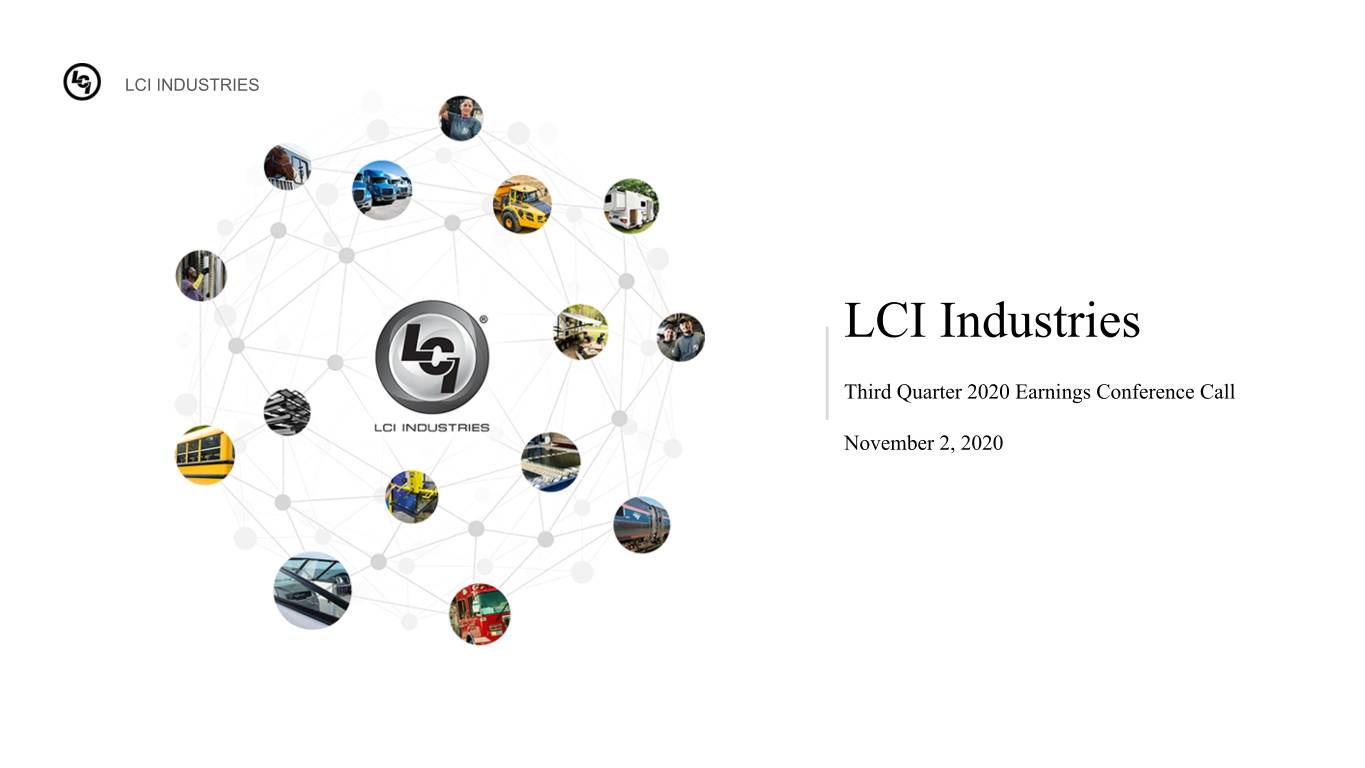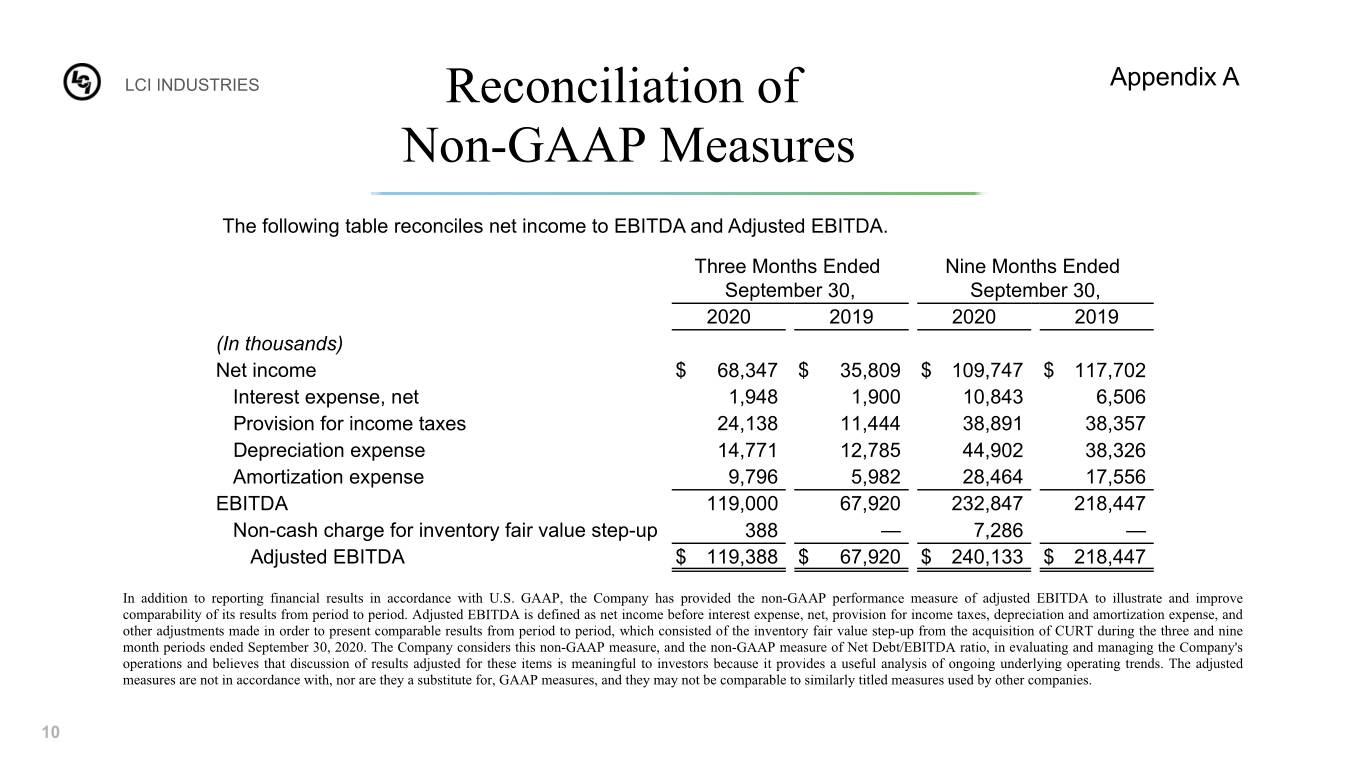Attached files
| file | filename |
|---|---|
| EX-99.1 - EX-99.1 - LCI INDUSTRIES | lcii2020q3results.htm |
| 8-K - 8-K - LCI INDUSTRIES | lcii-20201102.htm |

LCI INDUSTRIES LCI Industries Third Quarter 2020 Earnings Conference Call November 2, 2020 1

LCI INDUSTRIES Forward-Looking Statements and Non-GAAP Financial Measures This presentation contains certain “forward-looking statements” with respect to our financial condition, results of operations, business strategies, operating efficiencies or synergies, competitive position, growth opportunities, acquisitions, plans and objectives of management, markets for the Company’s common stock, the impact of legal proceedings, and other matters. Statements in this presentation that are not historical facts are “forward-looking statements” for the purpose of the safe harbor provided by Section 21E of the Securities Exchange Act of 1934, as amended, and Section 27A of the Securities Act of 1933, as amended, and involve a number of risks and uncertainties. Forward-looking statements, including, without limitation, those relating to the Company's future business prospects, net sales, expenses and income (loss), capital expenditures, tax rate, cash flow, financial condition, liquidity, consumer demand, integration of acquisitions, R&D investments, and industry trends, whenever they occur in this presentation are necessarily estimates reflecting the best judgment of the Company's senior management at the time such statements were made. There are a number of factors, many of which are beyond the Company’s control, which could cause actual results and events to differ materially from those described in the forward-looking statements. These factors include, in addition to other matters described in this presentation, the impacts of COVID-19, or other future pandemics, on the global economy and on the Company's customers, suppliers, employees, business and cash flows, pricing pressures due to domestic and foreign competition, costs and availability of, and tariffs on, raw materials (particularly steel and aluminum) and other components, seasonality and cyclicality in the industries to which we sell our products, availability of credit for financing the retail and wholesale purchase of products for which we sell our components, inventory levels of retail dealers and manufacturers, availability of transportation for products for which we sell our components, the financial condition of our customers, the financial condition of retail dealers of products for which we sell our components, retention and concentration of significant customers, the costs, pace of and successful integration of acquisitions and other growth initiatives, availability and costs of production facilities and labor, team member benefits, team member retention, realization and impact of expansion plans, efficiency improvements and cost reductions, the disruption of business resulting from natural disasters or other unforeseen events, the successful entry into new markets, the costs of compliance with environmental laws, laws of foreign jurisdictions in which we operate, other operational and financial risks related to conducting business internationally, and increased governmental regulation and oversight, information technology performance and security, the ability to protect intellectual property, warranty and product liability claims or product recalls, interest rates, oil and gasoline prices and availability, the impact of international, national and regional economic conditions and consumer confidence on the retail sale of products for which we sell our components, and other risks and uncertainties discussed more fully under the caption “Risk Factors” in the Company’s Annual Report on Form 10-K for the year ended December 31, 2019, and in the Company’s subsequent filings with the Securities and Exchange Commission. Readers of this presentation are cautioned not to place undue reliance on these forward-looking statements, since there can be no assurance that these forward-looking statements will prove to be accurate. The Company disclaims any obligation or undertaking to update forward-looking statements to reflect circumstances or events that occur after the date the forward-looking statements are made, except as required by law. This presentation includes certain non-GAAP financial measures. These non-GAAP financial measures should not be considered a substitute for the comparable GAAP financial measures. A reconciliation of these non-GAAP financial measures to the most directly comparable GAAP financial measure is included in this presentation. 2 2

LCI INDUSTRIES Third Quarter 2020 Highlights Leveraged leading production capabilities to capture record RV industry retail demand, driving double digit sales and EPS growth Substantial growth in Aftermarket and International markets, significantly advancing diversification strategy Generated solid cash flow and further deleveraged to enhance overall financial position Delivered growth in content per vehicle for both towable and motorized RV, enabled by development of innovative new products and strong brand recognition 3 3

LCI INDUSTRIES RV OEM • Retail demand continued its historical momentum throughout the quarter, expected to remain at elevated levels heading into 2021 ◦ Q3 2020 RV OEM revenues up 32% YoY (wholesale shipments up 37% YoY) ◦ Total consolidated net sales in September and October up 43% and 25% respectively YoY, driven by an increased shift in demand toward the RV lifestyle ◦ Further diversified net sales mix, with North American RV OEM accounting for less than 51% of total net sales(1) • New product innovation and market share gains accelerated growth in content per towable RV ◦ Content per towable RV: $3,428, +5% YoY(2) ◦ Content per motorhome: $2,399, +3% YoY(2) • Record amount of new buyers support the long-term growth prospects of the RV lifestyle ◦ Consumer desire to find safe, alternative outdoors activities that enable social distancing will help to drive sustainable growth ◦ Recent KOA survey reported 82 million active camper households in the U.S. ◦ Recent RVIA survey reported 70% of RVers historically remain in the lifestyle and upgrade units 4 over the long-term (1)For trailing twelve months ended September 30, 2020 4 (2)For trailing twelve months ended September 30, 2020, adjusted to remove impact of Furrion sales from all prior periods

LCI INDUSTRIES Expanding Markets Executing on our diversification strategy to reach goal of 40% North American RV OEM by 2022 Currently at less than 51% of total net sales for the TTM ended September 30, 2020 Aftermarket Adjacent Markets International ◦ Aftermarket Q3 sales up 149% YoY ◦ Adjacent industries Q3 sales up 11% ◦ International Q3 sales up 69% YoY YoY ◦ CURT business exceeding pre-COVID ◦ European countries returning to forecasts, realizing stronger-than- ◦ Marine continuing to benefit from normalized outputs, in-line with expected cost synergies secular tailwinds, driving strong growth rates in U.S. markets from a growth in the quarter few months ago ◦ Significant tailwinds from increased RV demand, particularly in the used RV ◦ The integration of the PWR-ARM ◦ Driving growth through opportunities components market brand of electric biminis and our new created by our Polyplastic, Lewmar SureShade brand continue to drive Marine, Lavet, Femto, and Ciesse ◦ Launched Lippert Care Center to allow growth in the market, in-line with acquisitions for enhanced support and additional diversification strategy 5 focus on customer needs 5

LCI INDUSTRIES Third Quarter Innovation Highlights Innovation: a critical part of our strategy ◦ R&D expertise and innovation remains a core component of LCI’s long-term strategy ◦ Demand for OneControl continues to build as OEMs increasingly adopt electric versus manual products ◦ Synergies within LCI enable R&D teams to identify further innovations within a wide range of products in our portfolio, including windows, shade systems, and awnings 6 6

LCI INDUSTRIES Growth Strategy Integrating and Realizing Synergies from New Acquisitions ◦ LCI remains focused on realizing new synergies from our most recent acquisitions, preserving cash, and paying down debt in the near-term ◦ Maintaining a robust pipeline of M&A targets split evenly across all market segments and are open to small and strategic tuck-in acquisitions Capitalizing on Ability to Win Market Share ◦ Growing market leadership in adjacent markets, international markets, and the aftermarket segment through enhanced engineering and innovation Continued Focus on Stated Capital Allocation Goals ◦ Investment in the business ◦ Reduce leverage ◦ Return capital to shareholders ◦ Execute strategic acquisitions 7 7

LCI INDUSTRIES Consolidated Net Sales by Market YoY Q3 2020 Financial Performance +32% Consolidated Net Sales Operating Margin RV OEM (in thousands) +11% $827,729 11.4% $586,221 8.4% ADJACENT OEM Third Quarter 2019 Third Quarter 2020 Third Quarter 2019 Third Quarter 2020 +149% Consolidated Net Income Adjusted EBITDA (in thousands) (in thousands) AFTERMARKET SEGMENT $68,347 $119,388 $35,809 $67,920 +69% Third Quarter 2019 Third Quarter 2020 Third Quarter 2019 Third Quarter 2020 8 INTERNATIONAL Additional information regarding adjusted EBITDA, as well as reconciliation of this non-GAAP financial measure to the most directly MARKETS 8 comparable GAAP financial measure, is provided in Appendix A.

LCI INDUSTRIES Liquidity and Cash Flow As of and for the Nine Months Ended September 30, ($ in millions) 2020 2019 Cash, Cash Equivalents $68.2 $27.5 Remaining availability under Debt Facilities(1) $460.9 $548.7 Capital Expenditures $28.7 $47.8 Dividends $51.5 $47.5 Debt / Net Income (TTM) 4.6x(2) 1.9x(3) Net Debt / EBITDA (TTM) 2.0x(2) 0.9x(3) Cash from Operating Activities $212.5 $209.5 (1) Remaining availability under the debt facilities is subject to covenant restrictions and, in the case of $150 million of such availability, the lender's discretion. (2) Net Debt/EBITDA ratio is a non-GAAP financial measure and is calculated as follows: Debt of $636M, less Cash of $68M, resulted in Net Debt of $568M at September 30, 2020, divided by Earnings Before Interest, Taxes, Depreciation, and Amortization, "EBITDA" (Net Income of $139M adding back Interest of $13M, Taxes of $45M, and Depreciation and Amortization of $93M), resulting in $290M EBITDA for the twelve months ended September 30, 2020. The GAAP debt / Net income ratio was $636M / $139M or 4.6x. 9 (3) Net Debt/EBITDA ratio is a non-GAAP financial measure and is calculated as follows: Debt of $262M, less Cash of $27M, resulted in Net Debt of $235M at September 30, 2019, divided by Earnings Before Interest, Taxes, Depreciation, and Amortization, "EBITDA" (Net Income of $138M, adding back Interest of $8M, Taxes of $46M, and Depreciation and Amortization of $74M), 9 resulting in $266M EBITDA for the twelve months ended September 30, 2019. The GAAP debt / Net income ratio was $262M / $138M or 1.9x.

LCI INDUSTRIES Reconciliation of Appendix A Non-GAAP Measures The following table reconciles net income to EBITDA and Adjusted EBITDA. Three Months Ended Nine Months Ended September 30, September 30, 2020 2019 2020 2019 (In thousands) Net income $ 68,347 $ 35,809 $ 109,747 $ 117,702 Interest expense, net 1,948 1,900 10,843 6,506 Provision for income taxes 24,138 11,444 38,891 38,357 Depreciation expense 14,771 12,785 44,902 38,326 Amortization expense 9,796 5,982 28,464 17,556 EBITDA 119,000 67,920 232,847 218,447 Non-cash charge for inventory fair value step-up 388 — 7,286 — Adjusted EBITDA $ 119,388 $ 67,920 $ 240,133 $ 218,447 In addition to reporting financial results in accordance with U.S. GAAP, the Company has provided the non-GAAP performance measure of adjusted EBITDA to illustrate and improve comparability of its results from period to period. Adjusted EBITDA is defined as net income before interest expense, net, provision for income taxes, depreciation and amortization expense, and other adjustments made in order to present comparable results from period to period, which consisted of the inventory fair value step-up from the acquisition of CURT during the three and nine month periods ended September 30, 2020. The Company considers this non-GAAP measure, and the non-GAAP measure of Net Debt/EBITDA ratio, in evaluating and managing the Company's operations and believes that discussion of results adjusted for these items is meaningful to investors because it provides a useful analysis of ongoing underlying operating trends. The adjusted measures are not in accordance with, nor are they a substitute for, GAAP measures, and they may not be comparable to similarly titled measures used by other companies. 10 10

L C I I N D U S T R I E S Q&A
